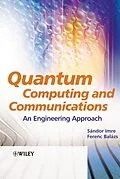Quantum computers will revolutionize the way telecommunications
networks function.
Quantum computing holds the promise of solving problems that
would be intractable with conventional computers by implementing
principles from quantum physics in the development of computer
hardware, software and communications equipment.
Quantum-assisted computing will be the first step towards full
quantum systems, and will cause immense disruption of our
traditional networks. The world's biggest manufacturers are
investing large amounts of resources to develop crucial
quantum-assisted circuits and devices.
Quantum Computing and Communications:
* Gives an overview of basic quantum computing algorithms and
their enhanced versions such as efficient database searching,
counting and phase estimation.
* Introduces quantum-assisted solutions for telecom problems
including multi-user detection in mobile systems, routing in IP
based networks, and secure ciphering key distribution.
* Includes an accompanying website featuring exercises (with
solution manual) and sample algorithms from the classical telecom
world, corresponding quantum-based solutions, bridging the gap
between pure theory and engineering practice.
This book provides telecommunications engineers, as well as
graduate students and researchers in the fields of computer science
and telecommunications, with a wide overview of quantum computing
& communications and a wealth of essential, practical
information.
Autorentext
Sandor Imre is head of the Department of Telecommunications at Budapest University of Technology and Economics in Budapest, Hungary. He has published over 250 peer-reviewed papers from global journals and at international conferences including many of IEEE COMSOC-sponsored conferences.
Ferenc Balazs is the author of Quantum Computing and Communications: An Engineering Approach, published by Wiley.
Zusammenfassung
Quantum computers will revolutionize the way telecommunications networks function.
Quantum computing holds the promise of solving problems that would be intractable with conventional computers by implementing principles from quantum physics in the development of computer hardware, software and communications equipment.
Quantum-assisted computing will be the first step towards full quantum systems, and will cause immense disruption of our traditional networks. The world's biggest manufacturers are investing large amounts of resources to develop crucial quantum-assisted circuits and devices.
Quantum Computing and Communications:
- Gives an overview of basic quantum computing algorithms and their enhanced versions such as efficient database searching, counting and phase estimation.
- Introduces quantum-assisted solutions for telecom problems including multi-user detection in mobile systems, routing in IP based networks, and secure ciphering key distribution.
- Includes an accompanying website featuring exercises (with solution manual) and sample algorithms from the classical telecom world, corresponding quantum-based solutions, bridging the gap between pure theory and engineering practice.
This book provides telecommunications engineers, as well as graduate students and researchers in the fields of computer science and telecommunications, with a wide overview of quantum computing & communications and a wealth of essential, practical information.
Inhalt
Preface.
How to use this book.
Acknowledgements.
List of Figures.
Acronyms.
PART I: INTRODUCTION TO QUANTUM COMPUTING.
1. Motivations.
2. Quantum Computing Basics.
3. Measurements.
PART II: QUANTUM ALGORITHMS.
4. Two Simple Quantum Algorithms.
5. Quantum Parallelism.
6. Quantum Fourier Transform and its Applications.
PART III: QUANTUM-ASSISTED SOLUTIONS OF INFOCOM PROBLEMS.
7. Searching in an Unsorted Database.
8. Quantum Based Multiuser Detection.
9. Quantum Based Code Breaking.
10. Quantum Based Key Distribution.
11. Surfing the WEB on Quantum Basics.
PART IV: APPENDICES.
12. Mathematical Background.
13. Derivations Related to the Generalized Grover Algorithm.
14. Complex Baseband-Equivalent Description of Bandlimited Signals.
15. Useful Links.
References.
Solution of Exercises.
Index.
